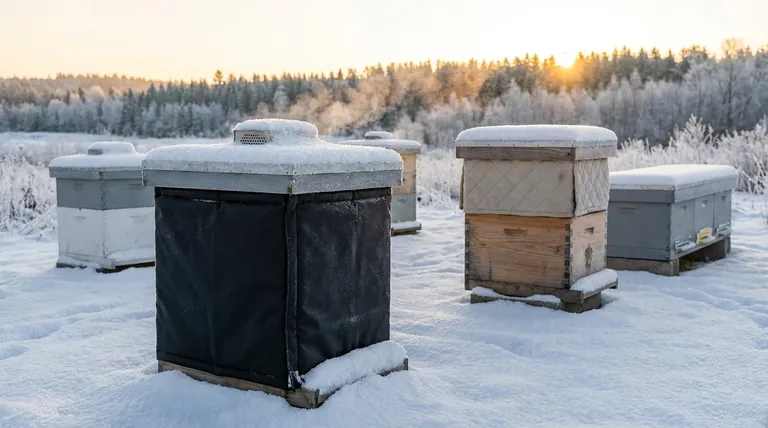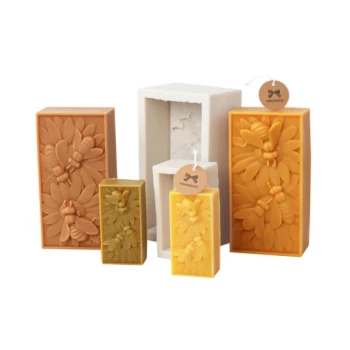While many beekeepers ask for a single "best" hive for winter, the reality is that nearly any modern hive can succeed, provided you manage the two critical winter challenges: moisture and heat loss. However, certain designs are inherently better suited for the cold. Hives like the Warré are designed with winter survival in mind, featuring a smaller thermal footprint and a built-in system for moisture control, while horizontal hives offer easy size adjustments to help the colony stay warm.
The "best" winter hive isn't a specific model, but rather a system that allows the beekeeper to effectively manage moisture and conserve heat. Success depends more on proper hive configuration and preparation than on the brand name or style of the box itself.

The Two Enemies of a Wintering Colony
To understand which hive is best, you must first understand what you are fighting against. A wintering colony faces two primary threats that a good hive design helps mitigate.
Enemy #1: Trapped Moisture
Bees generate a significant amount of warm, moist air through respiration as they cluster together and consume honey.
When this humid air rises and hits a cold inner cover or lid, it condenses into water. This cold water then drips back down onto the bee cluster, chilling and killing the bees far more effectively than cold air alone.
Enemy #2: Wasted Heat
Bees do not heat the entire hive; they heat their cluster by vibrating their flight muscles. This process consumes a tremendous amount of energy in the form of honey stores.
A larger-than-necessary interior space forces the colony to expend more energy to maintain its core temperature, burning through vital food reserves and increasing the risk of starvation.
Comparing Hive Designs for Winter Performance
Different hive styles manage moisture and heat with varying degrees of natural effectiveness.
The Warré Hive: Designed for Insulation
The Warré hive was specifically designed by its creator to mimic a natural tree hollow, a structure optimized for overwintering.
It features a "quilt box" at the very top of the hive, filled with an absorbent material like wood shavings. This quilt insulates the top of the hive and, more importantly, absorbs the rising moisture, preventing condensation from dripping on the bees.
Its smaller, square cross-section also encourages a more vertical, energy-efficient cluster shape, reducing the surface area through which heat can be lost.
The Horizontal Hive: The Advantage of Adjustability
Horizontal hives, whether a Langstroth or Top Bar style, possess a key advantage: easily adjustable interior volume.
Using a "follower board," a solid divider that fits the hive's profile, a beekeeper can shrink the colony's living space to the exact size they occupy. This drastically reduces the amount of air the bees must warm, making it one of the most efficient winter configurations.
The Langstroth Hive: The Adaptable Workhorse
The Langstroth is the most common hive in North America, but its large rectangular boxes and flat top are not inherently ideal for winter. The large space is difficult to heat, and the flat inner cover is a major source of condensation.
However, a Langstroth can be made very effective for winter with modifications. This involves adding foam insulation boards to the outside, wrapping the hive, and, most critically, creating a "moisture quilt" or spacer at the top to provide insulation and absorb condensation.
Understanding the Trade-offs
No single hive design is perfect for every beekeeper. Your choice involves balancing winter performance with other management considerations.
Warré Hives: Less Intervention, Less Control
The Warré's excellent winter design comes at the cost of management simplicity. Inspections are more disruptive, and honey harvesting is not as straightforward as with a Langstroth hive.
Horizontal Hives: Excellent Wintering, Slower Spring Build-up
While fantastic for winter, the horizontal layout can sometimes limit the queen's laying pattern in the spring. This can lead to a slightly slower population boom compared to vertical hives where the queen can move upward freely.
Langstroth Hives: Maximum Flexibility, Maximum Responsibility
The Langstroth is the undisputed king of modularity and equipment availability. This flexibility, however, means the beekeeper bears the full responsibility for preparing it for winter, as its base design does little to help.
Choosing the Right Approach for Your Colony
Your decision should be based on your beekeeping philosophy and how hands-on you plan to be during the season.
- If your primary focus is a low-intervention, natural approach: The Warré hive's design inherently manages moisture and heat, making it an excellent choice.
- If your primary focus is simplicity and ease of winter management: A horizontal hive allows you to easily adjust the colony's living space with a follower board, which is the most efficient way to conserve heat.
- If your primary focus is flexibility and you already own a standard hive: A Langstroth hive can be made perfectly winter-ready with proper insulation, moisture control, and space reduction.
Ultimately, a successful winter depends not on the hive you buy, but on the dry, well-fed, and properly ventilated environment you create within it.
Summary Table:
| Hive Type | Key Winter Advantage | Key Winter Disadvantage |
|---|---|---|
| Warré Hive | Built-in quilt box absorbs moisture; small thermal footprint. | Inspections are disruptive; honey harvesting is complex. |
| Horizontal Hive | Easy space reduction with a follower board for efficient heating. | Can limit the queen's spring expansion, slowing build-up. |
| Langstroth Hive | Highly adaptable with modifications and readily available parts. | Requires significant beekeeper intervention for winter prep. |
Ensure Your Apiary is Winter-Ready with HONESTBEE
Protecting your investment through the cold months is critical. At HONESTBEE, we supply commercial apiaries and beekeeping equipment distributors with the durable, high-quality supplies needed to prepare any hive for winter—from moisture quilts and insulation to follower boards and more.
Let us help you safeguard your colonies. Our wholesale-focused operations ensure you get the reliable equipment your business depends on.
Contact HONESTBEE today for a quote on winter-ready beekeeping supplies.
Visual Guide

Related Products
- Professional Insulated Winter Hive Wrap for Beekeeping
- Professional Galvanized Hive Strap with Secure Locking Buckle for Beekeeping
- Multi-Function Hive Tool with Integrated Hammer for Beekeeping
- Professional Drop-Style Hive Handles for Beekeeping
- Beekeeper Cowboy Hat and Veil for Beekeeping
People Also Ask
- Should bee hives be insulated? Protect Your Colony from Moisture, Not Just Cold
- How does insulation help bee hives in severely cold weather? Conserve Energy & Ensure Colony Survival
- What are the durability features of Bee Blankets? Built to Last in Demanding Apiary Conditions
- Why is insulation important for hives during winter? Ensure Your Bees Survive and Thrive
- Why is it important to insulate beehives during winter? Boost Your Colony's Survival Rate



















